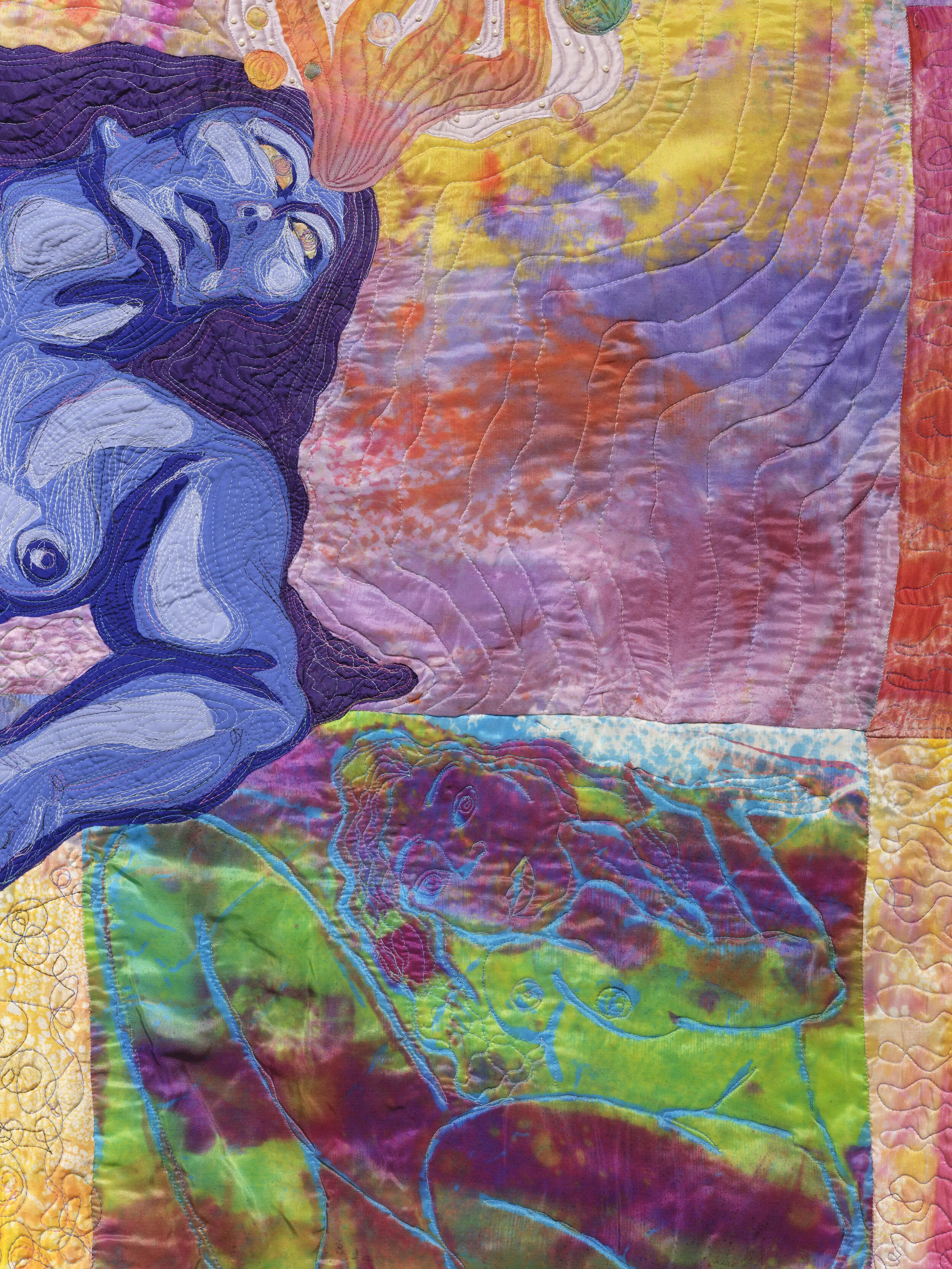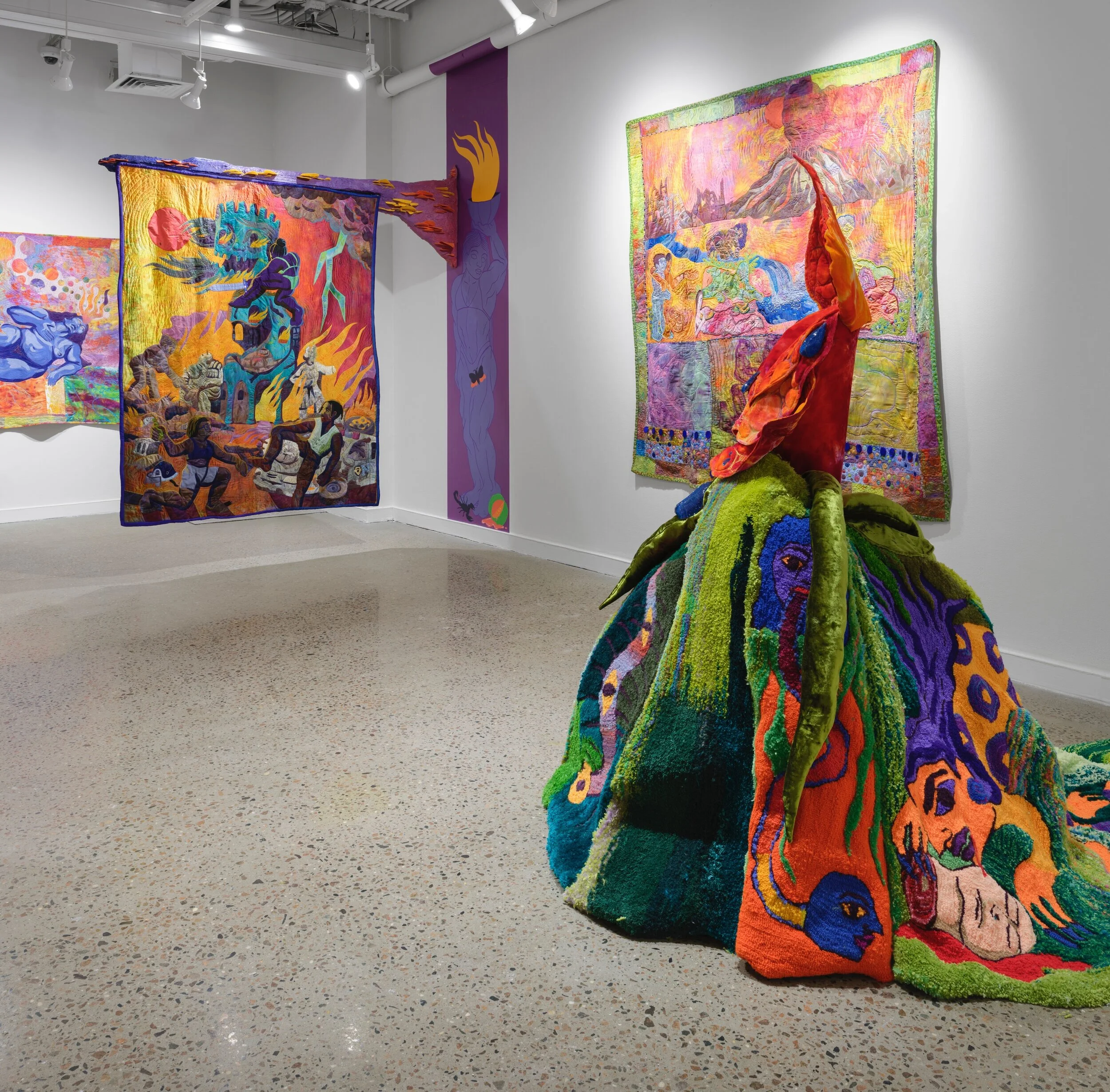Emily Oliveira is an interdisciplinary artist whose textiles, videos, installations, and performances explore the relationship between craft, labor, and queer futurity. The imagery is drawn from an array of influences, including science fiction, catholic and new age devotional art, technicolor films, and psychedelia. Her performances use original music, handmade sets and costumes, drag, and re-performance, with text drawn from popular culture, and idiosyncratic research. Her current work centers around intertwining sci-fi narratives in a queer, utopian future. This series uses textiles, video, performance, and immersive installation to transform these narratives into an expansive and interconnected mythology for a future earth.
Oliveira is a graduate of the Rhode Island School of Design, studied performance at Brown University, and is currently an MFA candidate at Yale. She has exhibited and performed in venues including Vox Populi, Wave Hill, Disclaimer Gallery, SPRING/BREAK Art Show, Paradice Palase, SOHO20, Judson Memorial Church, and Brown University. She has received awards and residencies from MAD, AIR Gallery, Yaddo, BRIC, The Tides Institute, and Ars Nova. She was a 2019 Van Lier Fellow at Wave Hill, and a 2020 NYSCA/NYFA Artist Fellow – in 2023, she will be the Abbey Awards Fellow at the British School at Rome.
Her solo show ‘I Saw God and She Wasn’t Made of Money’ is on view at BRIC until May 2nd.
For more information, please see: www.emily-oliveira.com, and on Instagram @emilyoliveirastudio.
Emily Oliveira, The Goddess, Asleep, Is Bitten by a Cosmic Snake and Thereby Hallucinates the Universe into Existence, 2019-2020. Hand-dyed silk, cotton thread, freshwater pearls. 45”(H) x 78"(W). Photo by Sebastian Bach.
Emily Oliveira, The Goddess, Asleep, Is Bitten by a Cosmic Snake and Thereby Hallucinates the Universe into Existence (detail), 2019-2020. Hand-dyed silk, cotton thread, freshwater pearls. 45”(H) x 78"(W). Photo by Sebastian Bach.
First, and most importantly, how are you doing? How are you navigating the highs and lows?
I’m ok, I feel exceptionally lucky that I’m safe and healthy and that no one close to me has had a major health crisis. The isolation and feeling out of contact with my community has obviously been difficult for everyone over the past year. I’ve been trying to deal with it mostly by throwing myself into my work, and trying to engage and meet outdoors with friends safely whenever possible.
Emily Oliveira, Everything Must Go (Lenda Murray Slays the Last Living King and We Awake to Find that We are Figures in Our Own Mythology, In Our Hands, the Tools for a Cosmic Redirection), 2020-2021. Hand-dyed silk and cotton, cotton thread, crystals. 75" (H) x73" (W). Photo by Sebastian Bach.
Emily Oliveira, Everything Must Go (Lenda Murray Slays the Last Living King and We Awake to Find that We are Figures in Our Own Mythology, In Our Hands, the Tools for a Cosmic Redirection) (detail), 2020-2021. Hand-dyed silk and cotton, cotton thread, crystals. 75" (H) x73" (W). Photo by Sebastian Bach.
It's my experience that most artists engage with some level of self-isolation in their day to day art practice. Has this been your experience? And if so, have you found these innate rhythms to be helpful during this larger, world-wide experience of isolation?
I feel like I adapt to isolation pretty well; it’s part of the reason I like going to residencies. I’m an easily distracted person who is also very social, so having the in-person social aspect of my life almost entirely taken out of the equation helped me focus on my work. Like most people, this isolation also made me profoundly sad! Being a part of a large queer community is not only important for my personal life, but it is an integral part of my work, and being physically separated from that community has been difficult. I think especially being isolated from our communities at an all-time high for racist, xenophobic, and classist state violence has been particularly difficult for people, myself included. But I have also felt a sense of urgency around creating images of revolution and futurity in this context. I have been enjoying having friends remotely pose for reference images, it’s been bringing me a lot of joy to be able to place my friends in these imagined futures. It’s such a gift that they allow me to use their image and their body in this way, and I hope that seeing themselves in this work is transportive for them.
Installation view of I Saw God and She Wasn’t Made of Money at BRIC, 2021. Multimedia installation. Dimensions variable. Photo by Sebastian Bach.
Emily Oliveira, hidden beneath the leaf mold, beneath the ferns and mushrooms, a flower as small as a fingernail, white as milk, 2020. Hand-dyed cotton, cotton batting, crystals, gold plated beads, glass beads. 38"x38”. Photo by Max Branigan.Emily Oliveira, hidden beneath the leaf mold, beneath the ferns and mushrooms, a flower as small as a fingernail, white as milk, 2020. Hand-dyed cotton, cotton batting, crystals, gold plated beads, glass beads. 38"x38”. Photo by Max Branigan.
Emily Oliveira, Oxalá, Pois vejo vir vindo no vento, Cheiro de nova estação, Eu sinto tudo na feridaviva, Do meu coração, 2020-2021. Hand-dyed silk velvet, wood, acrylic, wool, cotton. 55”(H) x 67”(D) x 30”(W). Photo by Sebastian Bach.
It would be great if you could briefly talk us through your practice. Understanding it is integral to appreciating the multivalence of your work.
I tend to identify as an interdisciplinary artist because I work across video, performance, sculpture, and installation, and my relationship to medium is generally pretty expansive, but textiles are absolutely the core of my practice. Almost all of my work responds to, or is drawn from, the narrative imagery in my quilts and rugs. I think about these works as artifacts of the future, with a slippery relationship to being and not-yet-being. The textile processes I keep returning to are embroidery, rug-making, quilting, and beading. Almost all of the processes that I use involve repeatedly piercing a substrate, and integrating new fibers into the existing structure of a textile; these processes sort of serve as a metaphor for piercing the veil between our world and the world as it might be, and creating little pinholes for us to gaze through.
In my practice, quilting is about the interconnectedness and dependent origination of ourconsciousnesses, and in this quilting and stitching together of consciousnesses, we become all that which makes up the divine. This blending together of disparate materials creates quilted portals between our present and a potential utopian future.
A friend of mine told me that my installation at BRIC made her feel like a “child alien coming into contact with an ancestral future”, which highlights the kind of disjointed or circular relationship with time that my work has.
Emily Oliveira, There Is No More Work in the Shadow of the Holy Mountain That Has Become the Volcano, 2020. Hand-dyed silk and cotton with glass beads and crystals. 74”x74”. Photo by Sebastian Bach.
Emily Oliveira, There Is No More Work in the Shadow of the Holy Mountain That Has Become the Volcano (detail), 2020. Hand-dyed silk and cotton with glass beads and crystals. 74”x74”. Photo by Sebastian Bach.
What is bringing you solace, or even joy, in this moment?
I’ve taken a lot of joy in science fiction and fantasy, particularly Star Trek, Miyazaki movies, LeGuin, Octavia Butler, Sam Delany, Vonda N. McIntyre, Begum Rokeya. I’ve been thinking a lot about imaginative fictions that are transportive, rather than escapist, that challenge our perceptions of the world rather than soothe and reaffirm them. Caring for my growing collection of plants, and starting a collection of different varieties of passion flowers has been a fulfilling experience. Introducing my best friend to Star Trek and kind of engaging in that mutual sci-fi fantasy with her has brought me a lot of joy!
Emily Oliveira, The vessel and the blood boiling into air between us, Kissing we were breathing, And dying from the temporary ecstasies, we let go, Into the depths of one another, Go, We went, We sang, And God, Was a feeling we gave to ourselves, 2021. Jacquard weaving with cotton and rayon. 47" (H) x108" (W). Photo by Sebastian Bach.
Emily Oliveira, The vessel and the blood boiling into air between us, Kissing we were breathing, And dying from the temporary ecstasies, we let go, Into the depths of one another, Go, We went, We sang, And God, Was a feeling we gave to ourselves (detail), 2021. Jacquard weaving with cotton and rayon. 47" (H) x108" (W). Photo by Sebastian Bach.
Has any of your imagery shifted in a reflection to what's currently happening? And why, or why not?
Last spring, at the beginning of the pandemic, I definitely felt, not out of touch with creativity but out of touch specifically with generating imagery. I wanted to make work, but I felt so scattered with worrying about my family, finances, mass death, state violence, everything that everyone else was also experiencing at that time, and continuing to experience now one year into the pandemic. I needed something to keep my hands busy to keep me from checking my phone every 5 seconds, so I started working on the abstract side of a two-sided quilt. I wanted to get into an aspect of quilting that leans more toward piecing and more meditative processes, working line by line with 2”x2” squares. It was a creatively and emotionally helpful process that was like an anchor for me during that time of exceptionally heightened unease and instability. When I was able to focus enough to start drawing again and start planning new figurative work, and particularly the narrative image on the other side of that quilt, I started to plan a seven-quilt series that I will be working on for the next few years. The image in each quilt takes place at a different time of day, with a cyclical narrative influenced by the idea of revolution as a continuous rather than linear act, leisure and frivolity in the morning are made possible by the revolutionary acts in the late afternoon, which are made possible through the events of all of the quilts both following and preceding them. This past year has definitely emphasized the urgency of collective action and collective imagining, using our time, skills, and our imaginations to remake the world. And for me that remaking starts with casting off capitalist constraints on our idea of the kind of futures available to us.
Installation view of I Saw God and She Wasn’t Made of Money at BRIC, 2021. Multimedia installation. Dimensions variable. Photo by Sebastian Bach.
Installation view of I Saw God and She Wasn’t Made of Money at BRIC, 2021. Multimedia installation. Dimensions variable. Photo by Sebastian Bach.
Installation view of I Saw God and She Wasn’t Made of Money at BRIC, 2021. Multimedia installation. Dimensions variable. Photo by Sebastian Bach.














